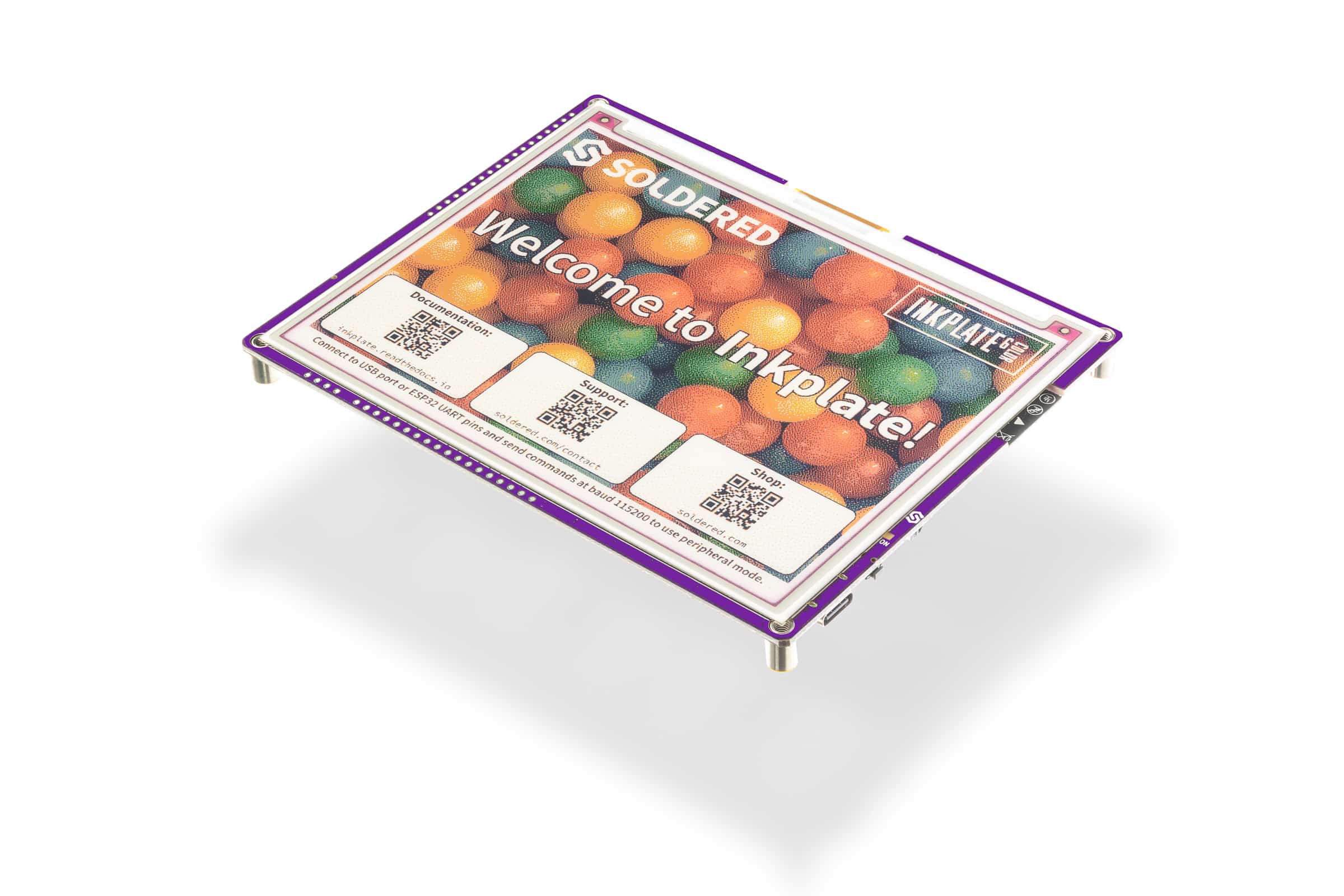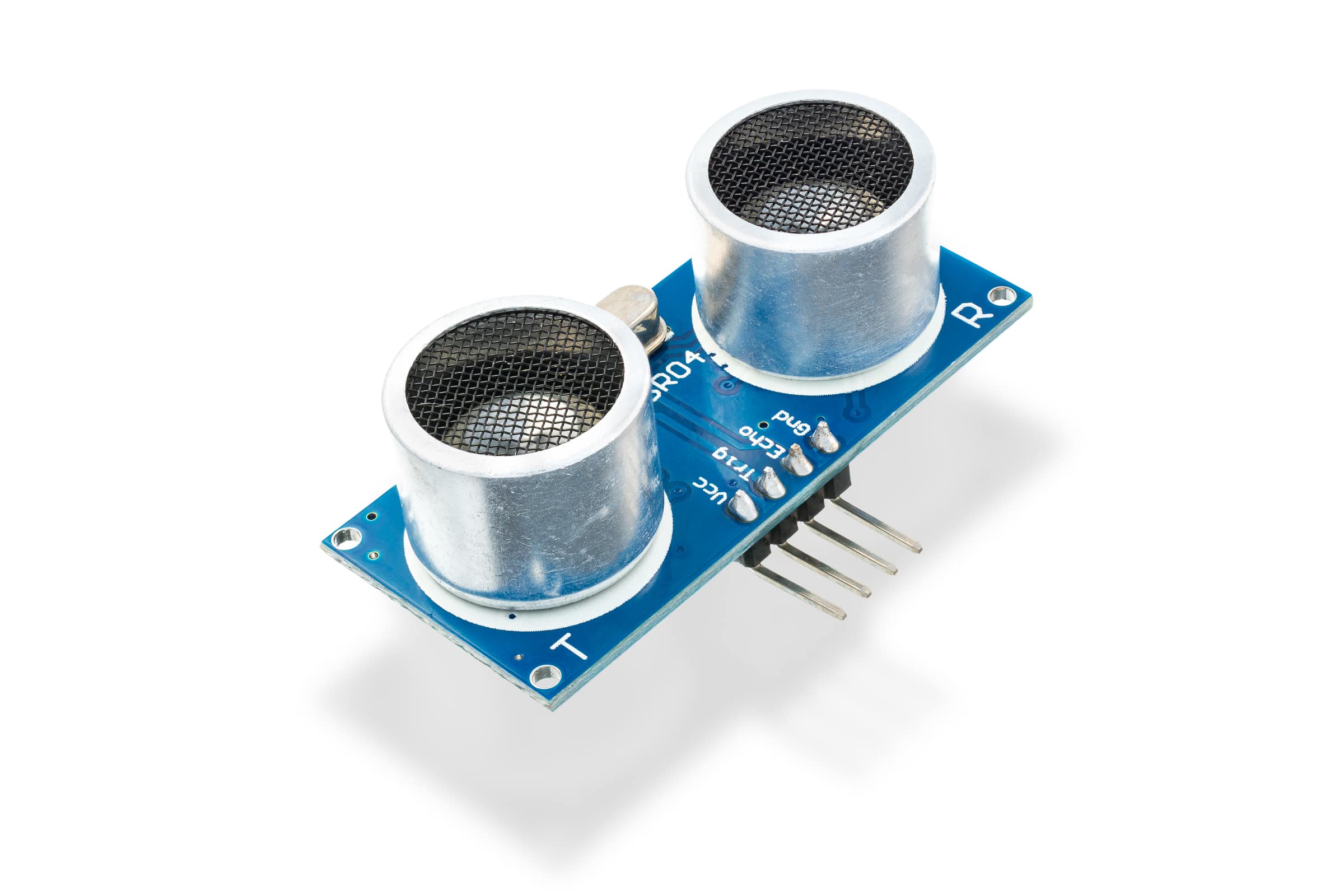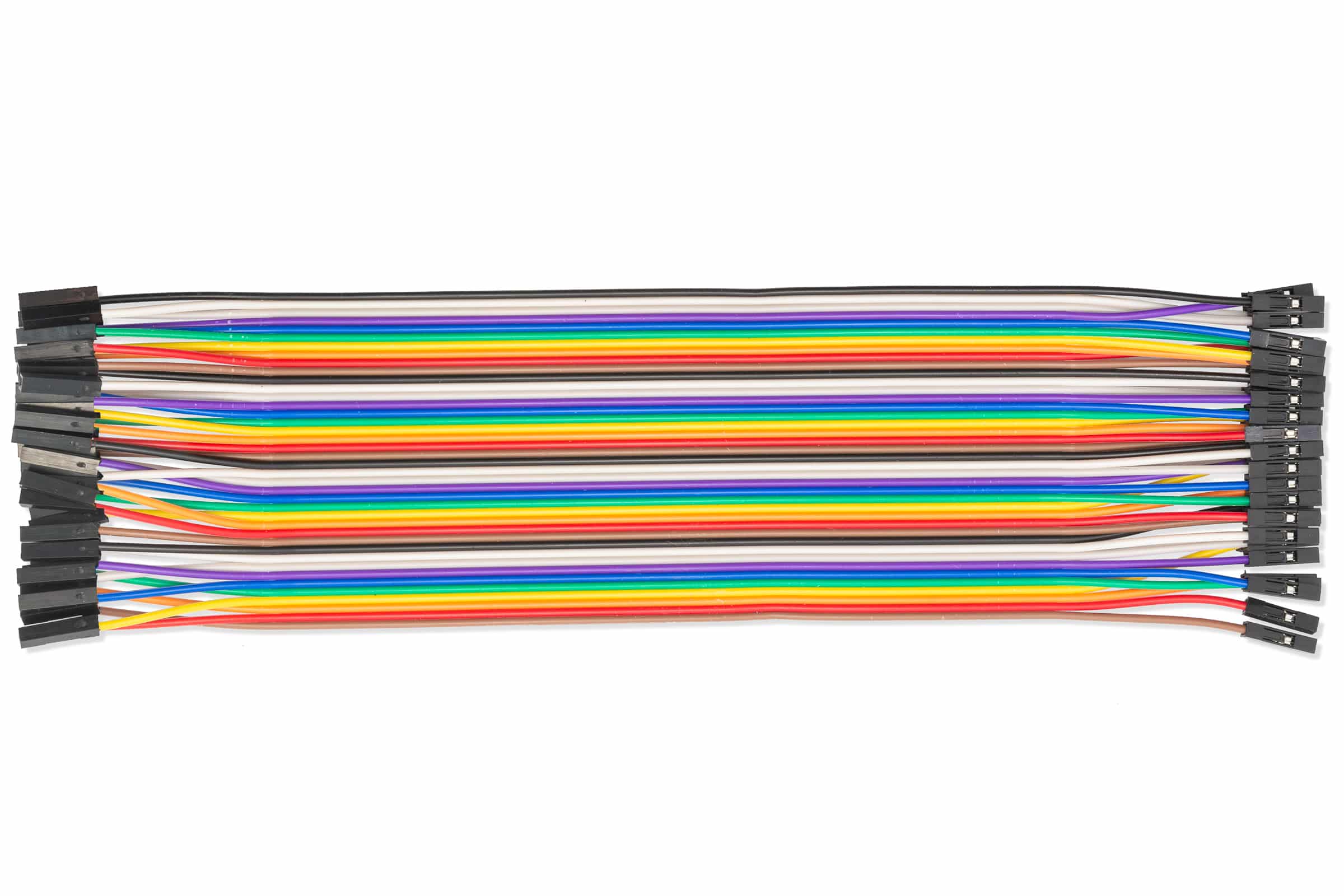-
Sub-total: Subtotal: $4.47
- Dasduino (Arduino-compatible)
- Inkplate
- easyC ecosystem
- Raspberry Pi & Micro:bit
- Breadboards & Cables
- Batteries & Power supplies
- Kids
- Sensors
- Actuators
- Communication
- Tools & Lab equipment
- Soldering kits
- Components
- Sale
Shop
24/7 free customer and technical support
Comprehensive documentation
Open-source hardware and software
2-year Warranty - no questions asked
Showing 1–24 of 684 resultsSorted by average rating

Set of cables designed to connect to the experimental board. These wires aren’t as flexible as our classic set of cables and they are cut in a variety of lengths. Using these wires, your breadboard will look very neat!

This set of cables makes component conjugation when prototyping or testing much faster and easier. Set consists of 10 cables that have alligator connection on each end so you could hook it to any component easily. Moreover, your work will be even simpler because of different cable colors in the set.

Over the years of working on new products, prototyping and experimenting, we have collected many different electronic components and PCBs. You could probably have one drawer for which you are no longer certain what it contains. Imagine this on a greater scale- that’s what we ended up with 🙂
Now we have decided to get rid of it. We made packages with these components, tried getting everyone more or less the same value and decided to sell them for HRK30 per pack. Well if you want to try your luck – here’s the chance!
NOTE: All packages are randomly packed and there is no option to select a special package. Since this is a sale, these products can not be returned and no refunds are available if you aren’t happy with what you got.

Sg90 servo is the type of motor that can turn the lever that is hitched to it very precisely and in that way control different things. This little servo motor is great for education and demonstration, but can also be used for real things that do not need great power for circumvolution (for example small vents).

Set of cables that are used for connecting to the breadboard. The set contains 65 cables that are in different colors and lengths for easier recognition on the breadboard.

DHT22 is a temperature and humidity sensor with even more precise reading comparing to DHT11.

LCD display with HD44780 controller enables showing text, symbols, value or anything else that comes from Dasduino/Arduino. It is capable of showing 16 symbols in two lines and therefore can be used in many projects that need to send clearly visible and legible output information.

A breadboard is a piece of equipment that anyone who works with electronics must have. It enables connecting components and modules without soldering and in that way provides simpler testing, prototyping and learning. This breadboard is inside our Dasduino Beginner Kit.

5mm RGB LEDs in a classic through-hole version with 4 pins. Each one representing one color (+), while the longest pin being a common cathode (common negative) for all three colors.

A breadboard is a piece of equipment that anyone who works with electronics must have. It enables connecting components and modules without soldering and in that way provides simpler testing, prototyping and learning.

If you’re like us, you thought: “If only I could use a screen like this in my project”, first time you saw an e-book reader. Thanks to the exceptional sharpness and contrast, the ability to display in sunlight and truly unprecedented efficiency in terms of energy (it consumes energy only when changing the content on the screen), electronic paper is the ideal choice for many applications. Inkplate 6COLOR, continuing the tradition of the now well-known Inkplate series, continues to offer variations of e-paper accessible to hobbyists and everyone else in a way that we have made plug-and-play hardware, really easy to use and compatible with Arduino and micropython. Inkplate 6COLOR brings a unique innovation – the ability to display colors on the screen.
If we want to list only a few features, Epaper Inkplate 6COLOR has a 5.85-inch folded e-paper that displays a total of 7 different colors (Black, White, Red, Yellow, Blue, Green, and Orange). Considering the built-in dithering capability, the results you can get on the screen are really impressive. Powered by ESP32, you will have strong microcontroller with WiFi and Bluetooth on your disposal. It’s super-low-power (18uA) so you can use it for days, weeks, or months out of a single battery charge, and there is on-board Li-ion charger and RTC. Using our Arduino library (100% compatible with Adafruit GFX), it’s 5 minute work to get the board running for you. The Micropython module is available as well. It’s 100% open-source for both software and hardware.

Professional Li-ion battery charging requires CC/CV (Constant Current/Constant Voltage) technology to ensure safe, efficient charging while maximising battery lifespan. This Li-ion charger delivers professional-grade charging performance with 1A fast-charging capability, modern USB-C connectivity, and safety monitoring. Designed for Arduino projects, IoT devices, and portable electronics, this charger provides the reliable, high-current charging that demanding applications require. The integrated dual-LED status system and protection circuitry ensure safe operation, while the compact design enables easy project integration.
**IMPORTANT SAFETY AND USAGE REQUIREMENTS:** This charger provides CC/CV charging for single-cell 3.7V Li-ion/LiPo batteries only. Maximum recommended battery capacity is 4000mAh for optimal charging performance. Input voltage must be 4.5-5.5V via USB-C (standard USB power sources compatible). This board does not include reverse polarity protection, overvoltage protection, or short-circuit protection. Ensure correct battery polarity and inspect connections before use. For applications requiring protection features, consider our protected charger variant. Never leave charging unattended, monitor battery temperature during charging, and ensure adequate ventilation. Compatible with standard JST-PH-2mm battery connectors. Comprehensive technical documentation, charging guidelines, and safety protocols are available in our documentation resources below.
Product usage tips: The red LED glowing means the battery is charging. The green LED glowing means the battery is charged. Easy embedding into a project with the four mounting holes on the board. Comes with 5 pins that need to be soldered.
Note: This charger has no protection against reverse polarity, short-circuit, too high or too low voltage. If you’re looking for a charger with a protector, click here.

Dasduino Lite is the right choice when you are limited with space, but still looking for capable controller. Based on Attiny1604, with USB-C port, Li-ion charger and CH340 USB-UART converter, it has all must-haves on a small form-factor.
Only 38mm wide and 26mm high, Dasduino Lite contains 12 GPIO pins. Of these, 9 can be programmed as analog. It comes with a USB Type-C connection and is 100% compatible with the original Arduino IDE software using custom Board Definition. In addition to its small dimensions, which are the main characteristic of this Dasduino, there is also a charger for a lithium battery, a full RGB LED and an easyC connector that will allow easy connection of the Dasduino Lite board with other devices. This Dasduino is extremely handy when you need to make a project that needs to take up as little space as possible.
Dasduino LITE (ATTiny1604) options:
The Dasduino LITE comes in 3 versions depending on the method of establishing a connection to the pins:
– without headers
– with male headers
– with female headers

A classic small power with an output of 5V / 2A which will ideally supply your project with an Arduino / Croduino. The output is standard female USB connector (type A). You can directly connect a cable from the PCB to the charger and use it as a constant power source, or it can be used for charging up a mobile phone/tablet. Or for a third purpose ..? In any case, it will be enough!

Protoboard used for the permanent connection (also known as soldering) of electronic components. High quality, with solder mask on both sides, as well as column and row markings.

ESP8266 is an IC that delivers a true revolution in the world of makers, especially in the world of IoT (Internet of Things). This is a complete 32-bit SoC (System on Chip) with built-in flash memory, frame and EEPROM which can even be programmed directly from the Arduino interface, without the need for additional micro-controller. With all this, the most important point is that in itself has a built-in WiFi (AP, STA, AP + STA), all that for “little money”.
ESP8266 in this form (ESP-12) is suitable for direct soldering to a printed circuit board as an SMD component or directly solder the wires since the pin has its holes. It also comes with a PCB trace antenna.
Note: ESP8266 is an IC that works at 3.3V! Connecting directly to 5V, or track Arduino or Croduino plate will destroy it! Use logic level converter.

If you usually do big projects or put on workshops, you know that there’s never enough of some components. Therefore, we’ve put together this set of wires, resistors and other primary components to make your everyday work or education much easier.
This set consists of:
- Breadboard
- Set of cables for breadboard
- 50x 330ohm resistor
- 45x 10k resistor
- 10x 2n2222 transistor
- 10x 1n4148 diode
- 5x photoresistor
- 10x pushbutton
- 5x potentiometer 10k
- 2x 100nF ceramic capacitor
- 5mm RGB LED diode
- 3x 5mm blue LED diode
- 3x 5mm red LED diode
- 3x 5mm yellow LED diode
- 3x 5mm green LED diode

This module lowers the input voltage on the specified output voltage that you adjust through the trimmer on the board. It’s very practical because while changing the input voltage, the output voltage always stays the same. However, the input voltage has to be at least 0.7V higher than the output voltage.
Input voltage is IN+ and IN-, while the output is OUT+ and OUT- . A power supply is able only to bring the voltage down, not up!
It does not have a protective diode in case of the wrong polarity, pay attention while connecting!

RF transmitter and receiver is a high-quality combination for RF communication between two devices (eg. Dasduino) often used for remote controlling or wireless communication.

DS18B20 is a waterproof temperature sensor packed in metal and waterproof housing. For communication with Dasduino/Arduino, it uses only one wire and it is possible to put up to 127 sensors on one code and measure temperature in 127 different places by using just one wire!
Check out: „How to use a module?“ in the TUTORIAL section for the information on how to use the sensor, how to connect it to Dasduino/Arduino and downloading the library.

HC-SR04 is a widely used and popular sensor that can be used for measuring the distance between itself and the object that is placed in front of the sensor. Connecting to Dasduino itself is simple, the sensor requires only two codes for controlling and uses 5V voltage. There is also a library that provides us with distance information. Make sure you check „How to use module“ in the TUTORIALS category.

Set of female-female cables for connections with various modules and components.
• Quantity: 40 cables
• Cable lenght: 15cm
• different colors for easier recognition

BBC Micro:bit is well known in Croatia due to Croatian Makers project. Soldered is on its way to become the official distributor for Micro:bit in Croatia.
For those who are not familiar, micro:bit is small microcontroller board accompanied with bunch of sensors which makes learning programming logic easier, especially for kids. There are more than a few visual programming tools for this board which make programming really simple. It is programmed via USB port and besides sensors, it has 2 pushbuttons and 5×5 LED matrix display onboard.

Are you looking to start tinkering with electronics and Arduinos? Or perhaps you’re looking for a board to help you with electronic projects? Dasduino Core is the right choice for you. If you’re familiar with any of the retired Croduino products, you’ll feel right at home with this board. If not, no worries! Dasduino Core is made for makers of all skill levels! Not only will it execute the tasks in a breeze, but it will take up little space while doing so.
With just 63 mm wide and 22 mm high, Dasduino Core packs 22 I/O pins. It has 14 digital and 8 analog pins, which is plenty for almost all projects. It comes with a USB Type-C connection and is 100% compatible with the original Arduino boards and Arduino IDE. It comes with the Atmel Atmega328P microcontroller we all know and love. It works on 5V or battery voltage. There is also a 3.3V voltage regulator on the board for easy powering of 3.3V breakouts or easyC boards. Furthermore, it features Lithium-ion battery charger and connector, and a full color WS2812 RGB LED. An easyC connector will make connecting the Dasduino Core with other devices effortless.
Dasduino CORE (ATmega328) options:
The Dasduino CORE comes in 3 versions depending on the method of establishing a connection to the pins:
– without headers
– with male headers
– with female headers



